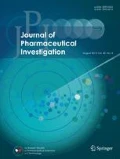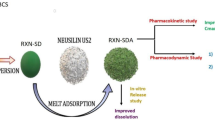Abstract
The present work is a comparative study that matches between carriers and techniques used to prepare solid mixtures with glimepiride. The study is directed towards elucidation of the most promising carrier capable of highly improving drug dissolution along with the most successful technique used for drug formulation. Mixtures were tested for drug content and dissolution. The most optimum formulae were characterized by DSC, IR and XRPD. Kinetic treatment of dissolution data was performed for physical and co-ground mixtures, solid dispersions and their adsorbates, triple solid dispersions and their adsorbates, microwave generated or treated solid dispersions. Results revealed that enhancing effect mostly reached maximum with ternary solid dispersion adsorbate (TSDads). The latter technique demonstrated a dramatic increase in drug dissolution rate which was reflected in the shortest half-life for most carriers at variable degrees. The highest dissolution rate was attained with pregelatinized starch and decreased to variable degrees with remaining carriers. Differences were ascribed to chemical nature as well as relative water solubility of carriers. The combined effects of incorporating surfactants, polymers and adsorbents to glimepiride contributed together to improve wetting, reduce crystallinity and caused substantial increase in the surface area which made TSDads the most promising technique for enhancing dissolution of glimepiride.

















Similar content being viewed by others
Abbreviations
- PM:
-
Physical mixtures
- CGM:
-
Co-ground mixtures
- SD:
-
Solid dispersions
- SDads:
-
Solid dispersion adsorbate
- TSD:
-
Triple solid dispersion
- TSDads:
-
Triple solid dispersion adsorbate
- MwGSD:
-
Microwave generated solid dispersion
- MwTSD:
-
Microwave treated solid dispersion
- PreGelSt:
-
Pregelatinized starch
- CP:
-
Crospovidone
References
Ahuja N, Katare OP, Singh B (2007) Studies on dissolution enhancement and mathematical modeling of drug release of a poorly water-soluble drug using water-soluble carriers. Eur J Pharm Biopharm 65:26–38
Al-Obaidi H, Ke P, Brocchini S, Buckton G (2011) Characterization and stability of ternary solid dispersions with PVP and PHPMA. Int J Pharm 419:20–27
Ammar HO, Salama HA, Ghorab M, Mahmoud AA (2006) Formulation and biological evaluation of glimepiride–cyclodextrin–polymer systems. Int J Pharm 309:129–138
Bergese P, Colombo I, Gervasoni D, Depero LE (2003) Microwave generated nanocomposites for making insoluble drugs soluble. Mater Sci Eng C23:791–795
Biswal S, Sahoo J, Murthy PN (2009) Physicochemical properties of solid dispersions of gliclazide in polyvinylpyrrolidone K90. AAPS PharmSciTech 10(2):329–334
Blagden N, de Matas M, Gavan PT, York P (2007) Crystal engineering of active pharmaceutical ingredients to improve solubility and dissolution rates. Adv Drug Deliv Rev 59:617–630
Boregowda SS, Rao BPR, Jayarama RA, Guruchar NLV (2011) Application of water-soluble/dispersible polymeric carriers in drug dissolution modulation. Asian J Pharm Sci 6(1):26–35
Branchu S, Rogueda PG, Plumb AP, Cook WG (2007) A decision-support tool for the formulation of orally active, poorly soluble compounds. Eur J Pharm Sci 32:128–139
Bühler V (2005) Polyvinylpyrrolidone excipients for pharmaceuticals. Povidone, Crospovidone and copovidone. Springer-Verlag, Berlin/Heidelberg
Cilurzo F, Selmin F, Minghetti P, Gennari CGM, Demartin F, Montanari L (2008) Characterization and physical stability of fast-dissolving microparticles containing nifedipine. Eur J Pharm Biopharm 68:579–588
de Waard H, Hinrichs WLJ, Visser MR, Bologna C, Frijlink HW (2008) Unexpected differences in dissolution behavior of tablets prepared from solid dispersions with a surfactant physically mixed or incorporated. Int J Pharm 349:66–73
Dureja DH, Madan AK (2007) Solid dispersion adsorbates for enhancement of dissolution rates of drugs. PDA J Pharm Sci Technol 61(2):97–101
Frick A, Möller H, Wirbitzki E (1998) Biopharmaceutical characterization of oral immediate release drug products. In vitro/in vivo comparison of phenoxymethylpenicillin potassium, glimepiride and levofloxacin. Eur J Pharm Biopharm 46:305–311
Goddeeris C, Willems T, Van den Mooter G (2008) Formulation of fast disintegrating tablets of ternary solid dispersions consisting of TPGS 1000 and HPMC 2910 or PVPVA 64 to improve the dissolution of the anti-HIV drug UC 781. Eur J Pharm Sci 34:293–302
Ilić I, Dreu R, Burjak M, Homar M, Kerč J, Srčič S (2009) Microparticle size control and glimepiride microencapsulation using spray congealing technology. Int J Pharm 381:176–183
Kawabata Y, Wada K, Nakatani M, Yamada S, Onoue S (2011) Formulation design for poorly water-soluble drugs based on biopharmaceutics classification system: basic approaches and practical applications. Int J Pharm 420:1–10
Kawakami K (2012) Modification of physicochemical characteristics of active pharmaceutical ingredients and application of supersaturatable dosage forms for improving bioavailability of poorly absorbed drugs. Adv Drug Deliv Rev 64:480–495
Khan N, Craig DQM (2003) The influence of drug incorporation on the structure and release properties of solid dispersions in lipid matrices. J Control Release 93:355–368
Kiran T, Shastri N, Ramakrishna S, Sadanandam M (2009) Surface solid dispersion of glimepiride for enhancement of dissolution rate. Int J PharmTech Res 1(3):822–831
Leuner C, Dressman J (2000) Improving drug solubility for oral delivery using solid dispersions. Eur J Pharm Biopharm 50:47–60
Li J, Liu P, Liu J, Zhang W, Yang J, Fan Y (2012) Novel Tanshinone II A ternary solid dispersion pellets prepared by a single-step technique: in vitro and in vivo evaluation. Eur J Pharm Biopharm 80:426–432
Martins RM, Siqueira S, Tacon LA, Freitas LAP (2012) Microstructured ternary solid dispersions to improve carbamazepine solubility. Powder Technol 215–216:156–165
Moneghini M, Bellich B, Baxa P, Princivalle F (2008) Microwave generated solid dispersions containing Ibuprofen. Int J Pharm 361:125–130
Moneghini M, Zingone G, De Zordic N (2009) Influence of the microwave technology on the physical–chemical properties of solid dispersion with Nimesulide. Powder Technol 195:259–263
Nakanishi S, Fujii M, Sugamura Y, Suzuki A, Shibata Y, Koizumi N, Watanabe Y (2011) Evaluation of the physicochemical characteristics of Crospovidone that influence solid dispersion preparation. Int J Pharm 413:119–125
Ning X, Sun J, Han X, Wu Y, Yan Z, Han J, He Z (2011) Strategies to improve dissolution and oral absorption of glimepiride tablets: solid dispersion versus micronization techniques. Drug Dev Ind Pharm 37(6):727–736
Parmar KR, Shah SR, Sheth NR (2011) Studies in dissolution enhancement of ezetimibe by solid dispersions in combination with a surface adsorbent. Dissolut Technol 8:55–61
Pouton CW (2006) Formulation of poorly water-soluble drugs for oral administration: physicochemical and physiological issues and the lipid formulation classification system. Eur J Pharm Sci 29:278–287
Rajpurohit VS, Rakha P, Goyal S, Dureja H, Arorac G, Nagpal M (2011) Formulation and characterization of solid dispersions of glimepiride through factorial design. Iran J Pharm Sci 7(1):7–16
Reddy MS, Fazal ul Haq SM, Apte SS (2011) Solubility enhancement of fenofibrate, a BCS class II drug by self emulsifying drug delivery systems. IRJP 2(11):173–177
Reven S, Grdadolnik J, Kristl J, Zagar E (2010) Hyperbranched poly(esteramides) as solubility enhancers for poorly water-soluble drug glimepiride. Int J Pharm 396:119–126
Roquette Pharma and Personal-Care (2012) Glycolys [on line]. Available at http://www.Roquette-pharma.com/glycolys-superdisintegrant-starch-tablets-capsules-glycolate/. Accessed on 9 Oct 2012
Shah VP, Konecny JJ, Everett RL, McCullough B, Noorizadeh AC, Skelly JP (1989) In vitro dissolution profile of water-insoluble drug dosage forms in the presence of surfactants. Pharm Res 6(7):612–618
Shah J, Vasanti S, Anroop B, Vyas H (2009) Enhancement of dissolution rate of valdecoxib by solid dispersions technique with PVP K 30 & PEG 4000: preparation and in vitro evaluation. J Incl Phenom Macrocycl Chem 63:69–75
Shohin IE, Kulinich JI, Ramenskaya GV, Vasilenko GF (2011) Evaluation of in vitro equivalence for drugs containing BCS class II compound ketoprofen. Dissolut Technol 2:26–29
Singh SK, Prakash D, Srinivasan KK, Gowthamarajan K (2011) Liquisolid compacts of glimepiride: an approach to enhance the dissolution of poorly water soluble drugs. J Pharm Res 4(7):2263–2268
Van den Mooter G (2012) The use of amorphous solid dispersions: a formulation strategy to overcome poor solubility and dissolution rate. Drug Discov Today 9(2):79–85
Vasconcelos T, Sarmento B, Costa P (2007) Solid dispersions as a strategy to improve oral bioavailability of poor water soluble drugs. Drug Discov Today 12(23/24):1068–1075
Vidyadhara S, Babu JR, Sasidhar RLC, Ramu A, Prasad SS, Tejasree M (2011) Formulation and evaluation of glimepiride solid dispersions and their tablet formulations for enhanced bioavailability. Pharmanest 1:15–20
Vippagunta SR, Maul KA, Tallavajhala S, Grant DJW (2002) Solid-state characterization of nifedipine solid dispersions. Int J Pharm 236:111–123
Waters LJ, Bedford S, Parkes GMB (2011) Controlled microwave processing applied to the pharmaceutical formulation of ibuprofen. AAPS PharmSciTech 12(4):1038–1043
Wei H, Löbenber RL (2006) Biorelevant dissolution media as a predictive tool for glyburide a class II drug. Eur J Pharm Sci 29:45–52
Zajc N, Obreza A, Bele M, Srčič S (2005) Physical properties and dissolution behaviour of nifedipine/mannitol solid dispersions prepared by hot melt method. Int J Pharm 291:51–58
Acknowledgments
The authors are grateful for the members of Pharmaceutics Department in National Research Center in Dokki, Cairo, Egypt for their continuous help and support in terminating the experimental work.
Conflict of interest
The authors report no conflicts of interest. The authors alone are responsible for the content and writing of this article.
Author information
Authors and Affiliations
Corresponding author
Electronic supplementary material
Below is the link to the electronic supplementary material.
Rights and permissions
About this article
Cite this article
Makar, R.R., Latif, R., Hosni, E.A. et al. Optimization for glimepiride dissolution enhancement utilizing different carriers and techniques. Journal of Pharmaceutical Investigation 43, 115–131 (2013). https://doi.org/10.1007/s40005-013-0061-8
Received:
Accepted:
Published:
Issue Date:
DOI: https://doi.org/10.1007/s40005-013-0061-8




